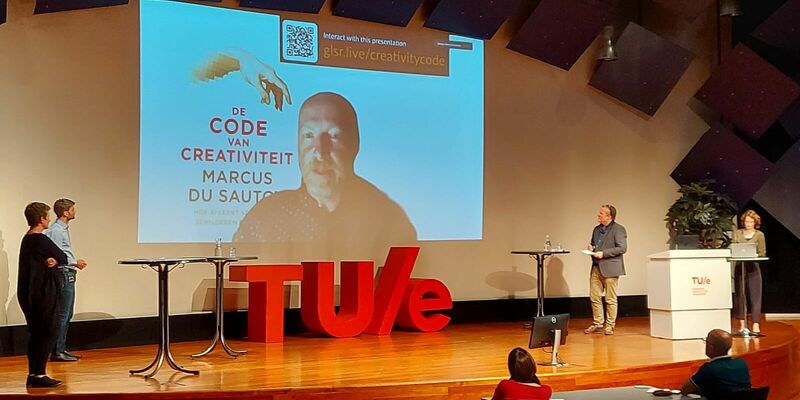
- Corona , The University , Research
- 17/09/2020
Creativity in times of corona
Studium Generale had yet another corona novelty Wednesday evening: a mixed online-offline lecture during which the main speaker was virtually present only. Well-known British mathematician and author of popular science books Marcus du Sautoy addressed the audience in the Blauwe Zaal via a video connection, while the local speakers – researchers Kristina Andersen and Jim Portegies – were physically present. The subject: artificial intelligence and creativity. The occasion: the Dutch translation of Du Sautoy’s book The Creativity Code
Studium Generale (SG) restarted its events on the campus this month, after it was forced to move its program fully online last spring. A significant number of lectures this fall can be attended physically – for example by a maximum of fifty people in the Blauwe Zaal – as well as online via a livestream. In principle, the speakers are physically present in this hybrid form, however, this wasn’t practical in Du Sautoy’s case, according to program maker Marle de Jonge of SG.
Under the current circumstances, the virtual podium on the large screen in the Blauwe Zaal proved to be the best alternative to still ‘bring Du Sautoy to TU/e’, De Jonge said. “We really wanted to have him in our program; he has many fans among the TU/e audience.” The other speakers from SG’s fall program will be physically present in principle, she emphasizes. “Unless someone suddenly turns out to have a cold and is forced to stay at home. In that case, we could still opt for this form.” The lecture, incidentally, was a joint initiative from SG, the Center for Humans & Technology, EAISI and the TU/e Young Academy of Engineering.
The Creativity Code
Du Sautoy’s lecture was originally planned for June, the program maker says. “The Dutch translation of his book was also supposed to appear that month. That was postponed due to corona, which is why he didn’t travel to the Netherlands.” The Dutch translation of Du Sautoy’s book The Creativity Code has now been presented after all. As far as De Jonge knows, the lecture in Eindhoven is the only appearance ‘in’ the Netherlands on the occasion of that event.
However, other speakers were physically present in the Blauwe Zaal: discussion leader professor Wijnand IJsselsteijn (director of TU/e Center for Humans & Technology) and researchers Kristina Andersen (Industrial Design) and Jim Portegies (Mathematics and Computer Science, and Eindhoven Young Academy of Engineering). Andersen and Portegies briefly talked about their experiences with the relationship between artificial intelligence and creativity, after which they and Du Sautoy answered audience questions (both from audience members in the hall and via internet).
De Jonge acted as a conduit for questions asked via Facebook and YouTube. “There were many substantive questions,” she says. “That’s encouraging. In addition, our audience that evening was about the same size as the maximum capacity of the Blauwe Zaal. And the lecture has been viewed by many people since. The lecture will also remain available on YouTube.” Indefinitely, in fact. “How long a lecture remains available for people to watch basically depends on the speakers; Marcus felt that having his story available online was a plus.”
Discussion